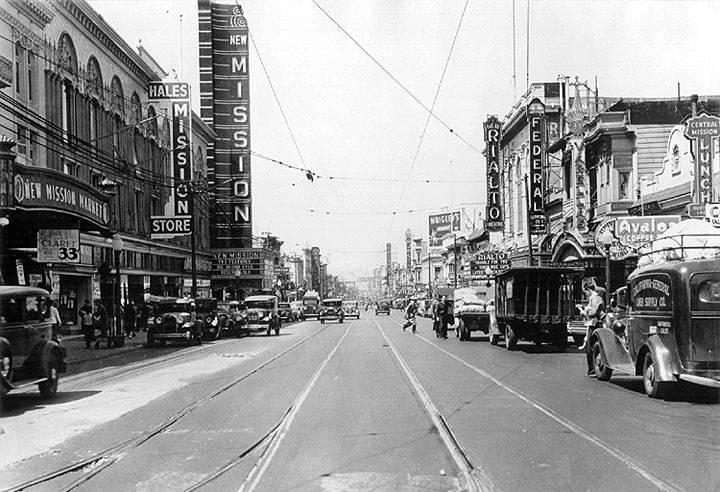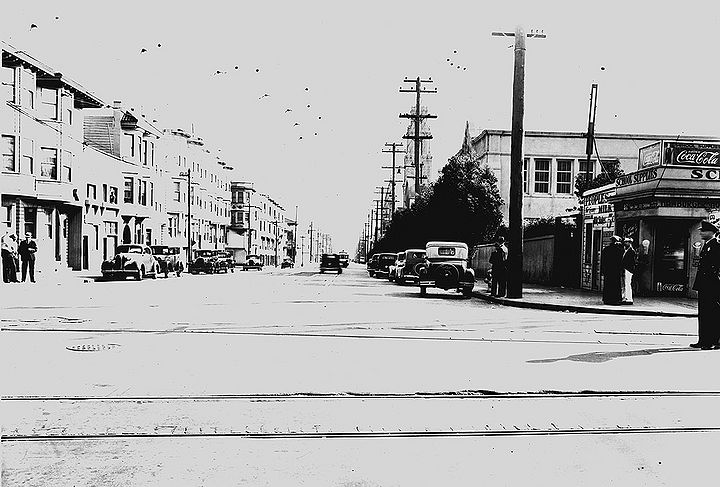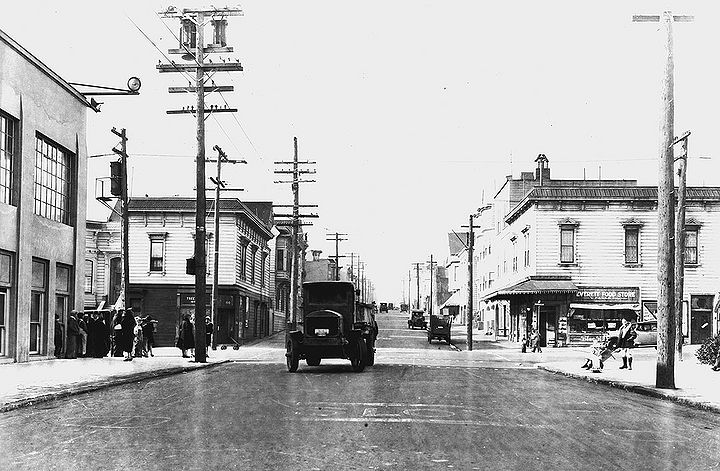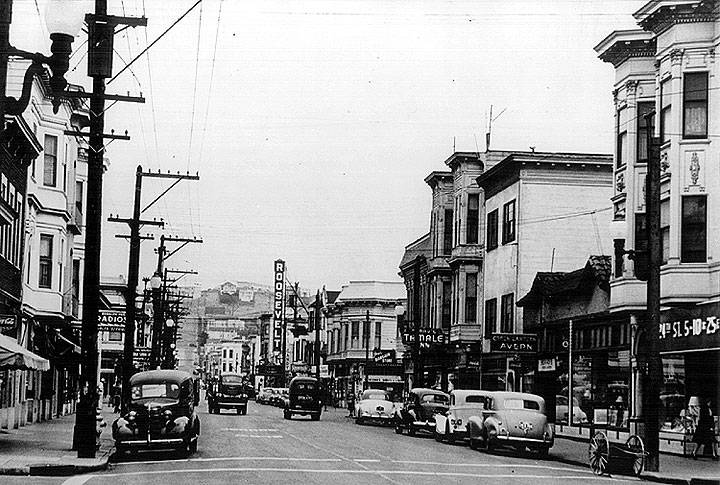Mission Life 1930s-40s
"I was there..."
by Dorothy Bryant
Mission Street looking north from 22nd Street, c. 1935.
Photo: Private Collection
Streetcar on Mission Street between 25th and 26th, c. 1930s.
Photo: C. R. collection
Lunch with a friend. She is researching the life of an eccentric artist who lived in the Mission District, on the northern slope of Bernal Heights, during the thirties and forties. "You grew up three blocks away during those years," she says. "What would have been the cultural surroundings influencing my artist?'
Cultural surroundings?
"You're Italian, like him. What was the Italian community like? How would they have related to my artist?"
Italian community?
First of all, I told her, you're from back east, where ethnic groups live in tighter, more homogenous neighborhoods. California has always been more integrated, at least among its Europeans. In the group of girls I hung out with, one was Southern Italian while I am Northern Italian (a vast difference in those days), one mixed Irish-German-Swedish, one Norwegian (with a Jewish boyfriend), one Greek, one Chinese (though most Asians still lived north of Market Street) and one newcomer from Oklahoma, with a history out of Steinbeck, who seemed most foreign of all to us San Franciscans. (Hispanics had barely begun to enter The Mission. African-Americans lived in The Fillmore and, as war build-up began, in Hunters Point). Those were the days when the "melting pot" philosophy opposed ethnic separatism, so that for better of for worse (a little of both) we were all anxious to act "American." When my grandparents spoke to me in Italian, I answered in English.
Furthermore. I have always wondered if the term "Italian Community" isn't an oxymoron. In my home there was only one "community" that mattered—the family. We gathered on every holiday—that's every holiday, including Labor Day, July 5th, Memorial Day, etc. and on each birthday—two or three times in some months. Our elders had a few friends, met on the job perhaps, but in some deep, unspoken way, these friends didn't really count. Only family counted, despite the undercurrents of unforgiven old slights or conflicts ever present at the obligatory, woman-labor-intensive gatherings that swallowed up the little time left over from hard work. A good family, especially in those hard times, was one that took care of its own and kept to itself.
"What about the church?" asked my friend. "Was that a center for community? Did it give a special flavor to daily life?"
To be sure, the Catholic Church so dominated The Mission, that for many of my childhood years I didn't know there were any other churches. Yet "dominated" is the wrong word. Grandmothers went to Saint Peter's or Saint Anthony's every Sunday—no one else I knew went regularly. I was never even baptized, but went to Mass along with my friends on holidays like Easter, when we all had new outfits to show off. Everyone was apparently Catholic, yet no one was very Catholic. Come to think of it, that might have been the strongest Italian influence. Italians (unlike the Irish, who ran the Church in America) take their religion as a right, a comfort, not as a guilt-tripping duty.
16th Street looking east from Church, 1937, with Mission Dolores Church one block down on right.
Photo: San Francisco History Center, San Francisco Public Library
17th Street west at Sanchez, 1928.
Photo: San Francisco History Center, San Francisco Public Library
"What about restaurants, coffee houses as gathering places?"
There were no coffee houses. There were bars, dark smelly caverns where some men hung out instead of bringing their wages home as any-decent-man-lucky-enough-to-have-a-job-ought-to. There were restaurants on Mission Street, but, remember, those were Depression days, and we couldn't afford to eat out. Even the fabled huge $1 dinners of the North Beach restaurants were a stretch for my family, reserved for weddings. Besides, my father, like most Italian men then and now, was a terminally fussy eater--nothing anywhere tasted as good as home-cooked. (As for trying a really cheap Chinese restaurant--you're kidding!) There were soda fountains where teenagers gathered after school, stretching a dime soda into two hours of giggling and flirting, but only during the brief high school interval before moving into marriage and family.
There were no bookstores. The public library was frequented mostly by children. Certainly there were no concert halls or performance spaces--those were all downtown and cost money. We had Seals Stadium on Sixteenth and Bryant, where local boys like Joe Dimaggio played, and an occasional game was affordable. But there too, the crowd was young and mostly male.
The Mission was working class in every sense. The buildings now housing artists' studios were working factories, breweries, tanneries. Trains carried raw materials and finished goods up and down Potrero Avenue. People walked from home to work and back again, seldom going anywhere else. "How would a reclusive, eccentric artist have been treated by his neighbors? " With a mixture of deference and cruelty--deference toward him as employed draftsman--white collar, middle class--and cruel ridicule of any "oddness" in his behavior, starting with any artistic inclination. I suspect his reclusive eccentricities were fed by isolation imposed by the attitudes of his neighbors. It wouldn't surprise me to learn that they knew nothing of his art--that he kept his paintings and writings, as well as himself, to himself, out of self-preservation. Certainly, as a child, I would have been astonished to learn that there was such a thing as an adult neighbor who painted pictures and wrote poems!
My friend gave up on me. I left her picking up a newspaper on the way home. There I found the answer for her. It was a story about plans to convert the York Theater, a run-down movie house on 24th and York Streets, to a theater performing plays with a "feminist, multicultural aesthetic." There--at 24th and York--was the center of the community of my childhood, if there was one. There was the shared experience of the whole neighborhood.
1935 view of 24th St. east from 24th and Florida. The Roozie (today the Brava Theater) is in the center.
Photo: Private Collection
1994 view of 24th St east from 24th and Florida; the theater's marquee shows it as the York.
Photo: Chris Carlsson
In those days it was called the Roosevelt (after Teddy) or more casually the "Roozie," as in, "Are you going to the Roozie tonight?" Usually the answer was yes. Remember, there was no TV in those days, and aside from a few shows like Jack Benny and an opera on Saturday afternoons, banal radio fare (popular music and snippets of trivial disinformation called news, like the worst a.m. radio stations today). And the Roozie was affordable. For less than a dollar a family of four like ours could purchase four hours of an aging double feature, plus cartoons, newsreels, and various other short subjects. The program changed three times a week, on Sunday, Wednesday, and Friday. Saturday afternoon was Kiddy Matinee-- from the age of six (younger if an older sibling could take us along), we children were given a dime and sent to a safe place from eleven in the morning till nearly five, a blessing for mothers with no baby-sitter, nor money to pay even if one existed.
Ah, the thirties. Movies starring Fred Astaire with Ginger Rogers, or Mickey Rooney with Judy Garland; simple comics like the Marx Brothers and Laurel and Hardy; sweet tough guys like Jimmy Cagney and Clark Gable; dramas starring Greta Garbo, John Barrymore, Bette Davis; screenplays directed by Alfred Hitchcock, Cecil B. DeMille, some of them even written by great writers like Faulkner, Odets, Fitzgerald. The golden age of the movies.
Well, yes and no. The legendary films now featured on cable TV or public TV, and studied by academics as well as movie buffs, appeared at the Roozie about a dozen times a year--three to five years after being released to downtown theaters. The other 300 or so movies a faithful Roozie attendee could see throughout the year have been deservedly forgotten, most probably destroyed. (They turned up on TV screens in the early days, but disappeared by the sixties.) We called them "B" movies, but on a school grading system such a film was about a D minus. It would be kind to refer to the plot as formula, and to the indistinguishable actors and sets as wooden--all of it thrown together, probably, in a few days of "writing" and shooting. One sign of the general opinion of most movies shown at the Roozie was the fact that no one bothered to check a schedule (if there was one) to find out what time a movie started. The projectors ran from six to midnight, people coming and going all the time. It didn't really matter when you walked in or out on most B movies. They were accepted with a shrug as cheap distraction for children and for their weary, worried parents.
There were other incentives for going to the Roozie. Wednesday was Dish Night. Every adult woman was given a piece of pottery that, week by week, built up to a set. You could walk into any home in the neighborhood and find us all eating from the same plates. Monday night was Bingo Night. A wheel was spun, and patrons punched out numbers on their cards until someone shouted "Bingo!" My father won once a "vanity set" -- a hand mirror and six glass, gilt-lidded make-up jars that shone empty on my mother's dresser for years--she didn't use make-up. But the big night was Saturday--Bank Night. All heads of households had filled out cards months or years before. At 8 p.m. on Saturday night the manager of The Roozie wheeled a glass drum out on stage, and three volunteers from the audience joined him. One turned the crank that spun the drum, mixing up the hundreds of little cards inside. Another (always a child) drew one card from the drum. A third volunteer silently read the name on the card, then handed it to the theater manager, who read the name aloud three times, with weighty pauses between calls, while everyone waited in silence for the exclamation of the lucky winner--for the prize on bank night was cash.
The prize started at ten dollars and grew by ten dollars more each week that it went unclaimed. As the sum grew, so did excitement in the neighborhood. Twenty dollars might be a week's wages to a man lucky enough to have a job. Sixty dollars could pay the rent for three months. One hundred dollars was a small fortune. When the pot began to build toward two hundred dollars, the Roozie would be packed on Saturday night. People bought tickets just to stand in the lobby, or even outside the theater, for if a ticket holder's name were called, he could collect even if he'd never gotten through the door.
I remember the time the prize rose to $610. The sidewalk in front and around the corner of the theater was mobbed. Neighbors stood around in an air of amused, yet hopeful excitement. They talked and laughed, met new neighbors, caught up on gossip, discussed movies and news and family and work or lack of it, while we kids played tag around them. Was this community? Probably it was as close as adults came to stepping across family lines, talking, at ease and with plenty of time, to the wider mix of neighbors. Probably such gatherings don't happen in today's TV-watching neighborhoods.
We never personally knew anyone who won Bank Night, though a neighbor once told us his cousin had won thirty dollars. A few years ago a friend told me that in 1938, as a young man in another state, he had been paid ten dollars to pose as the winner of a large Bank Night pot. Perhaps my parents and all our neighbors and all movie-goers across the nation were being cheated. If so, they were nevertheless sold a cheap ticket to hope and fun and relaxed socializing. They never seemed surprised or disappointed at not winning.
I am not nostalgic for those old days at the Roozie. By the time I was thirteen, I often as not stayed home alone preferring a book to whatever double feature the family went off to. Nor do I agree with those who say the steady diet of 1928-1944 movies was much less harmful than the steady diet of TV watched by many children today. There was less violence and no gross sex or language, but equal sexism, more racism and hypocrisy, and, of course, total heterosexuality. There were the same lies, materialistic values, evasions, distortions, false promises, illusions, and sheer stupidity that so seductively attack the ability of watchers to think straight.
Today The Mission has more crowds, dirt, and danger than during my childhood. But today even the poorest, least-educated people live a wider life there. The projected reincarnation of the Roosevelt/York Theater as Brava! for Women in the Arts is only one proof of it. My friend's eccentric artist might still be a recluse if he lived there today, but only by choice. I think he would fit in pretty well now.
Dorothy Bryant is the author of ten novels and five plays, many of them set in the Bay Area.






